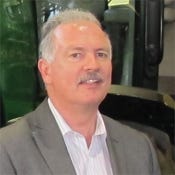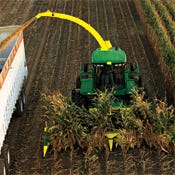John Deere Tractors Go Wireless For Remote TroubleshootingJohn Deere Tractors Go Wireless For Remote Troubleshooting
Deere & Co., the No. 2 company in the information 500, adds remote diagnosis to farm and construction vehicles to build closer customer ties.

Think of a green John Deere combine harvesting wheat in a remote corner of Kansas, or a tractor in a cornfield in Argentina. The nearest technician might be hours away, so any breakdown can cost precious work time. Now picture a Deere dealer calling to tell the farmer that it looks like the air filter is wearing out, so could he come out to replace it soon before it causes a problem.
On more than 40,000 newer Deere vehicles, in 43 countries, a dealer now can do that kind of remote preventive monitoring and also diagnose trouble codes when they appear. Launched in 2011, the Service Advisor Remote software can capture machine readings, clear codes if there is a false alarm, and even wirelessly download a fix to the vehicle if there's a software-related problem.
Deere & Co. has offered that kind of electronic diagnostics for 13 years, with its PC-based Service Advisor software. But that setup required a technician to visit the machine and connect the PC to it. As the coverage and bandwidth from cellular networks improved, and costs dropped, Deere decided it could add remote diagnostics, using a cellular service--with a satellite service option in some countries--that it calls JDLink.
And that decision threw the Deere IT team into a project unlike any it had done before.
Service Advisor Remote brings customer-facing IT to a new level. It had to integrate completely into the vehicles themselves, requiring intense quality and testing standards. And there was no room for missing a deadline--with Deere's manufacturing and marketing plans set, the new vehicles with the Service Advisor Remote option had to be ready to match that plan. For example, new U.S. environmental rules being phased in through 2015 require reduced emissions and thus will mean added complexity to the vehicles, so Deere saw a big value in remote diagnostics. The company wanted Service Advisor Remote ready as Deere rolled out vehicles that met those new standards.
One of the toughest challenges for the project's IT leaders, in fact, was coordinating their planning, deadlines, and processes with other business teams, including product engineering and marketing.

information 500 Top 5: Agile development boosts morale as well as speed, says Deere's Webber
Agile development boosts morale as well as speed, says Deere's Webber"We had to align with these other product cycles and make sure we were ready to deliver it at the right time when it was ready from a marketing standpoint," says Patrick Webber, who as VP of IT leads Deere's 2,500-person global IT operation. "As you do more of the consumer-oriented applications, you have to have really good discipline to make sure you're going to hit your dates, because you're working with a broader community."
When a dealer runs a remote diagnostic, the data is sent via the JDLink cellular service to Deere's data center. The dealer accesses it using a browser-based app and a client application, and the data is available to the vehicle owner, dealer, and Deere headquarters. Deere uses that data in two ways: It creates a database of problems and suggested remedies that dealer technicians can use, and it becomes "an early indicator that we can feed into the development process," Webber says, so that the company can spot problems sooner.
In developing the system, the Deere IT team worked hand in hand with product engineering and design teams to make sure it was delivering software that does what the product designers wanted and is as reliable as any knob, handle, or piston on the vehicle.
Agile programming techniques were the only way to go, Webber says, and this project marked a turning point in Deere's use of the development methodology.
Agile's Unexpected Benefits
Deere teams did two-week sprints to serve up working code regularly throughout the almost two-year-long development project to build Service Advisor Remote. IT pros would review and test that code with the product teams, and then either revise it or move onto new areas. Deere changed some of the office space at its Moline, Ill., headquarters to accommodate the agile sprints, which can include groups from several departments working alongside one another at times. At times, they even reorganized where people worked so they could have an actual Deere vehicle next to them for testing. To make sure testing covered vehicle operation end to end, teams were set up to make sure someone represented each component.
Testing was critical because of the high stakes that come with working on a customer-facing project. Of course, Deere believes it has high standards for in-house IT systems, but a problem in a customer-facing system would do a lot more damage than a glitch in, say, an internal email system, especially for a proud brand that dates back to 1837, when an Illinois blacksmith first devised a steel plow that could cleave through the thick Midwestern soil. "John Deere is known for the quality of our products, and the IT components had to be right at that level of quality," says Larry Brewer, director of global IT channel, who led the development project.
The new software--available on certain Deere tractors, combines, cotton pickers, and construction equipment--had to be integrated with all of the highly engineered mechanical systems and existing sensors on those vehicles, since at times repairs would involve doing remote updates of software that runs the machines. That integration within the vehicles, to the data center software, and out to the customer and dealer browser created the biggest technical challenge. "This isn't just an app," Webber says.
Besides speeding development and lowering costs, the move to agile boosts employee morale, Webber says, because "you can begin to see the value of what you're trying to deliver sooner. We all like to get the satisfaction of understanding what we're delivering."

information 500 Top 5: Deere - Out here, breakdowns are a problem
Out here, breakdowns are a problemAnd Deere is learning one more thing about agile programming: It's contagious. Some developers who worked on the Service Advisor Remote project are pushing for agile sprints on other projects.
Collaboration was another challenge, since the Service Advisor Remote team was in seven locations around the world. Most of the coding was done by Deere's staff in Pune, India, where the company has about 550 employees. Much of the technical architecture and design work happened in the U.S. Doing iterative development across the globe, and with key suppliers, meant relying on videoconferencing and instant messaging, as well as flexible scheduling to let people work when they needed to connect with colleagues in other time zones.
With the telematics platform built, Deere faces a new problem: "We're still trying to ask ourselves, now that we have this, what else should we do?" Webber says. Service Advisor Remote gives Deere a new connection to its customers--both the dealers who sell its gear and the farmers and construction workers who operate it.
Whatever the company decides, Deere IT fundamentally has changed. It's more prepared to work on the growing number of customer-facing tech projects sure to come.

Go to the 2012 information 500 homepage
About the Author
You May Also Like






